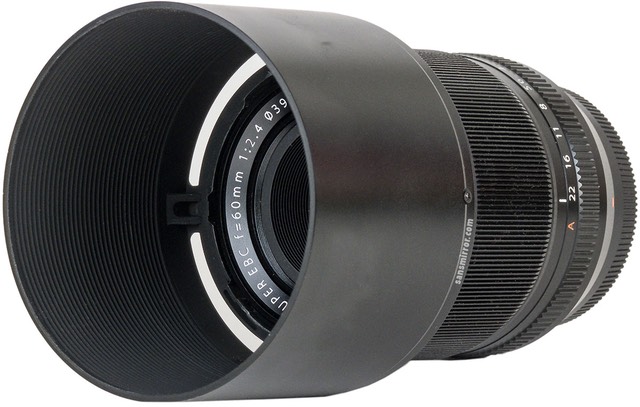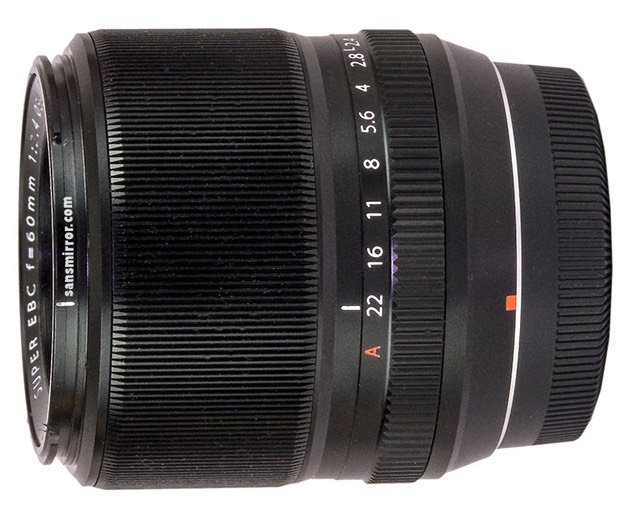
What is It?
For it's first fixed telephoto option, Fujifilm went with a hybrid approach. Why do I say that? Well, it's not quite a full-fledged macro lens (only gets to 1:2 life-size), and it's not a fast portrait lens (only equivalent to a 90mm f/2.4, when most people would want at least f/1.8).
Next to the mount is an aperture ring (goes to f/22), while up front is a very wide fly-by-wire focus ring.
The front element on the lens is highly recessed, enough so that you can shoot in side-light without a hood. But this has the curious side effect of Fujifilm putting recessed 39mm (!) filter rings inside the front markings. So, if you're paying attention, In the first five lenses Fujifilm put out we have 39mm, 52mm, and 58mm filter sizes. Good thing we don't use a lot of filters any more, but this is a bit of a problem, as it means carrying extra step up rings or filter sets.
The metal (!) lens hood is as deep as the lens (more on that in the next section). With the optical finder on the X-Pro1, you're going to see a lot of lens, and a lot of hood in your frame.
How's it Handle?
I've already hinted at my biggest problems with the lens: the small filter size means carrying a second set of filters for me (39-52mm step-up is a bit impractical). But it's the lens hood that annoys me the most. When reversed on the lens, if the lens isn't already mounted on the camera I almost always find that I'm also taking off the rear lens cap when I twist the hood off, as there isn't much lens left to hold onto when the hood is reversed. Now, some of this is me. Over the years, apparently, I've developed the habit of dealing with the hood when the lens is off the camera. I have to unlearn that with this lens. Still, it annoys me every time I have to deal with it. I've taken to just leaving the hood on, but then it's a long reach down to the lens cap.
Unfortunately, the lens cap, like most of the Fujifilm lens caps, doesn't exactly snap in easily or stay completely secure. The Fujifilm front-pinch caps are amongst some of the most fiddly I've used, and some are prone to pop off; the one for the 60mm lens is one of those. I keep finding the cap loose in the bottom of my bag.
The aperture ring is neither nicely tight, nor is it overly loose. I can live with the way it is on this lens more so than it is on some of my other Fujinon's, but I still wish it were a little tighter.

How's it Perform?
First I need to talk about focus performance. I haven't really written about that with the other lenses because they basically perform about as you'd expect. But the 60mm definitely is the turtle of the bunch. Especially as I moved into its macro range, I found that I was seeing slower focus lock and more hunting than I would have expected after using the other Fujinon lenses. It's not bad, but it definitely lags the others. Just warning you. (Note: make sure you're using current body and lens firmware; Fujifilm did make some adjustments that helped, but it's still not perfect.)
Center sharpness is excellent until about f/11 when diffraction is starting to intrude. The edge and corner sharpness of this lens are also excellent at f/4 and f/5.6, very good at other apertures. For a macro lens, that's a little surprising. This lens is better behaved than the other initial Fujinon primes in that the edges and corners aren't nearly as far from the central sharpness as they are on the 18mm and 35mm wide open. I'm very comfortable with the overall sharpness of this lens at pretty much all apertures, with f/5.6 being exceptionally good.
Linear distortion: visible pincushion in pure raw files, which gets corrected to a negligible .4% in JPEGs.
Vignetting: other than wide open, where there's about two-thirds of a stop of falloff, once you stop down you can pretty much ignore it.
Chromatic aberration: lateral chromatic aberration is low; this lens is about as good as it gets in that respect. I can measure some, but it's darned difficult to find in any image, even wide open. Longitudinal chromatic aberration is also reasonably low, though much more prevalent than in the 35mm f/1.4. There's a clear magenta shift forward of the focus point, and green behind. But "clear" doesn't mean "strong." This is still pretty good performance for a fast prime.
Bokeh: Very clean and simple up through about f/4. My sample has just enough aperture blade unevenness that I start to get slightly lopsided highlights at f/5.6 and can see one of the flat edges clearly. Still, very good overall and not nearly as objectionable as some recent lenses I've seen.

f/2.4 and 60mm give you the ability to isolate in macro shots, and the bokeh is very unencumbered with edging, colors, or other annoyances. Autofocusing can be slow when you're in this close, and if there's any wind moving those petals or any motion in your holding, you may also trigger a focus hunt. But macro shooters really should be disciplined and won't find this much of a problem.
Final Words
Despite the focus performance, which was worse than I'd like, this lens actually leaves a very good impression every time I use it. While you can't get to life-size with it, the macro shots I've taken with it have good "punch" and are very nicely sharp, even in corners (if the image has something in the corners). Even at f/2.4 the lens performs very well, and despite that slightly slow aperture, the lens still works nicely for candid portraits with a decent balance between DOF isolation and getting the entire face in full focus.
Early in my X-Pro1 usage, I found myself gravitating a lot to this lens, despite the focus shortcomings. It gives me good isolation ability without any undue restriction on how close I am, and it has a nice pop to the results. Even the bokeh seems well behaved and not intrusive.
It is a big lens, though, and on the bigger X-Pro1 body the combination is getting up their in size and weight. Still not quite in DSLR land, but a lot closer than most mirrorless aficionados probably want to get. Doesn't deter me, though. I like this lens.
Recommended (2012 to present)
Support this site by buying the lens from this advertiser:
